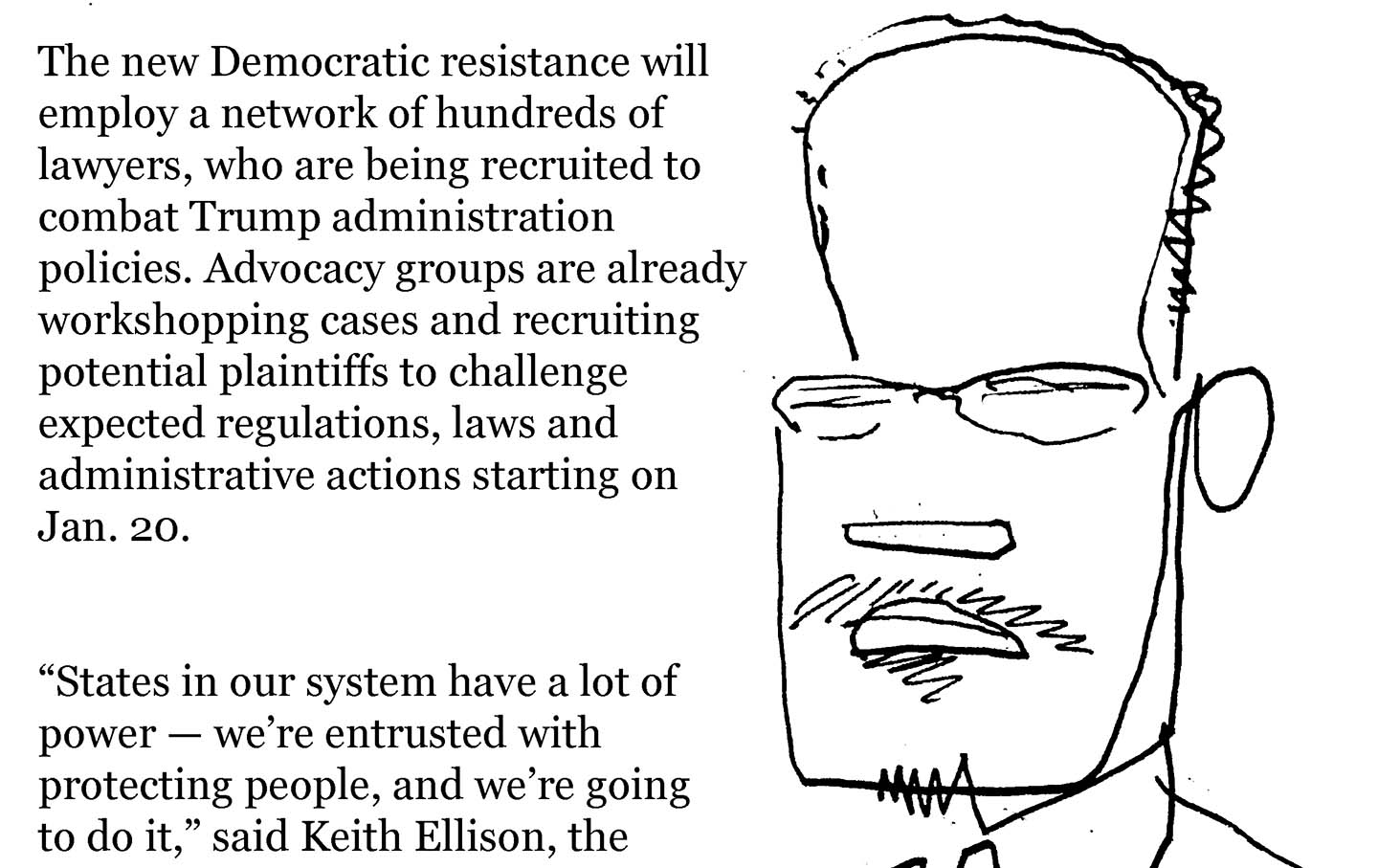Pennsylvania’s Undecided Voters Might Swing This Election
In an election in which polls have recorded a swing-state dead heat between Harris and Trump, even a tiny number might be enough to tilt the final result.
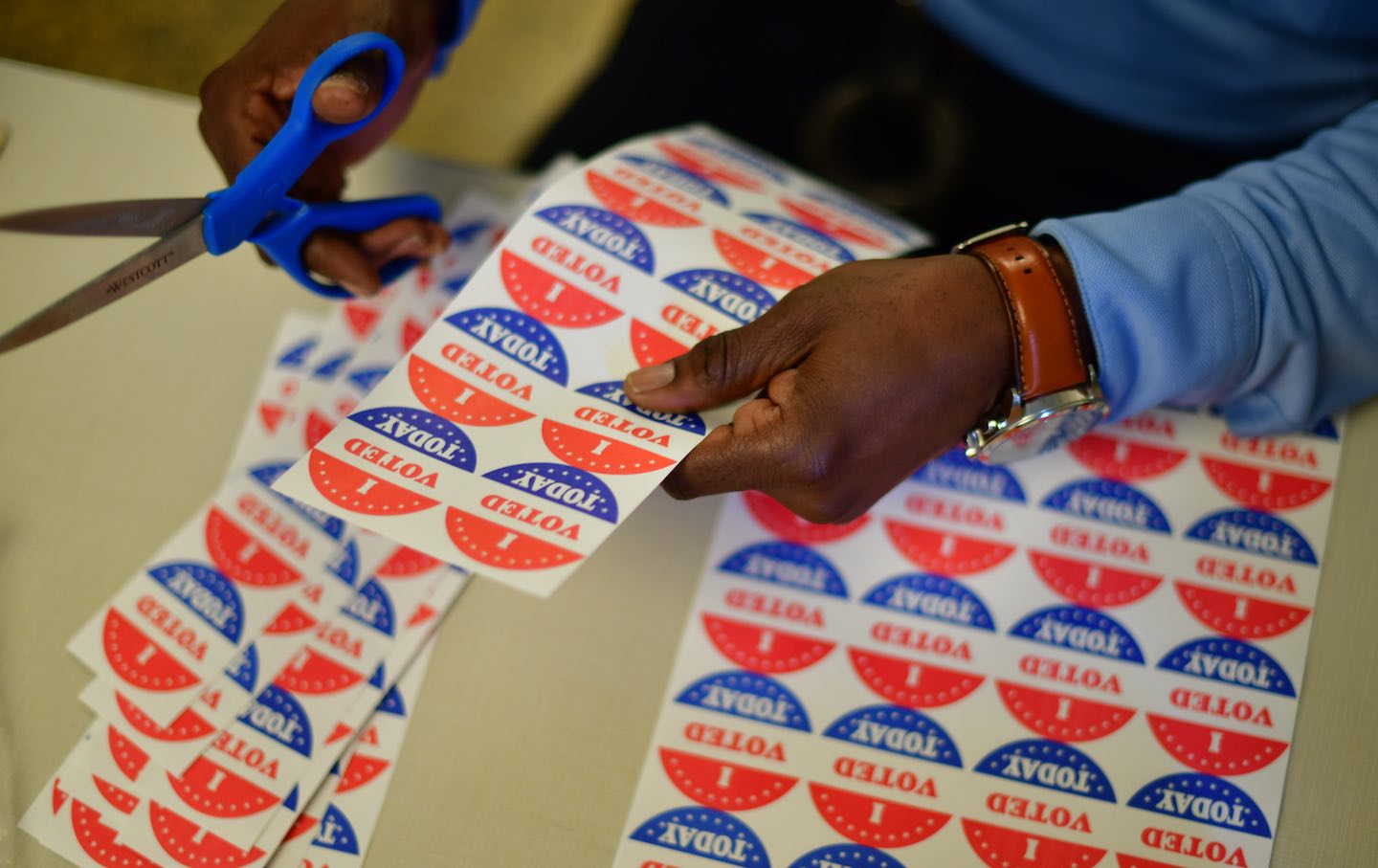
A volunteer cuts out stickers outside of a satellite polling station in Philadelphia, Pennsylvania.
(Mark Makela / Getty Images)
This article originally appeared at TomDispatch.com. To stay on top of important articles like these, sign up to receive the latest updates from TomDispatch.com.
If you’re like many of my friends, I know what you’re thinking: OMG, how is it even possible that half the country is going to vote for that guy? And there’s a slightly less common corollary to that: I mean, really, who are these people who say that they’re undecided? Who doesn’t know enough to know which way they’re going to vote?
Well, it turns out that I’ve met a fair number of those undecided voters in person, going door to door canvassing in eastern Pennsylvania, where, it’s fair to say, the 2024 election may be decided. They’re real people, with perfectly real everyday concerns. They have families living in pleasant suburbs in and around Easton, Bethlehem, and Allentown, their neatly tended lawns a mix of grass, crabgrass, and dandelions, and older model SUVs, minivans, and pickup trucks in their driveways. And I’d dare you to knock on one of their doors and, when someone answers, say, “So, who the hell are you?”
I get it: they’re easy to demonize, especially if you’re a liberal or leftist news junkie living on the Upper West Side of New York or in Takoma Park, Maryland, or Cambridge, Massachusetts; you read The New York Times, The Washington Post, The Boston Globe, or Politico; and your Monday nights are built around watching Rachel Maddow and Jon Stewart. I’m not surprised if, like Anne Enright, the novelist from University College Dublin, writing for “On the Election” in The New York Review of Books, you vent your pent-up frustration over undecideds who are “lonely and sometimes pathetically grandiose.” It upsets Enright to be “watching twelve billion election dollars chase down a few thousand anxious minds in Pennsylvania.” Can’t they just make up those minds of theirs?
To my mind, the forehead-slapping awe at those undecided in this presidential election took its purest form in a commentary by comedian and satirist Lewis Black on a recent episode of The Daily Show: “We still have no idea who the fuck is gonna win! And that’s all thanks to one very special group of morons.… Oh yes, undecided voters: the same people you see at the ice cream shop asking for 12 mini-spoon samples. It’s a $3 cone, asshole! How is anyone still undecided in this election?… This election still comes down to winning over a few dozen Pennsylvanians with carbon monoxide poisoning. Now, don’t get me wrong. Maybe these undecided voters aren’t stupid. Maybe they have a good reason for being idiots.”
But one Sunday afternoon, while crisscrossing several blocks in a neighborhood of Bethlehem, Pennsylvania, knocking on perhaps 40 front doors over several hours, I had the opportunity to talk to a number of those very undecideds. Out of the 40 homes curated from lists of Democrats and Democratic-leaning independents—those who had, in fact, voted in recent elections—about half of them were home and came to the door. And of those 20, maybe half a dozen told me that they hadn’t yet decided who they were going to vote for or if they planned to vote at all.
As a start, it turns out, a number of them haven’t really been following the news. According to research by the campaigns, many of them work two jobs. They don’t get the Times or the Post. Many, in fact, don’t even get the local paper. They know who’s running, but while they seemingly know a fair amount about Donald Trump, they know a lot less about Kamala Harris. They didn’t watch the two conventions on TV or even get around to watching the presidential debate between Harris and Trump. And, by the way, that puts them among the majority of Americans: An estimated 67 million people watched that event on September 10, while 158 million people voted in 2020 and an additional 81 million eligible voters who didn’t cast a ballot back then missed it or skipped it.
My sense, from the voters I talked to—totally unscientific, yes, but backed up by some polling and research—is that voters who say they’re undecided have largely tuned out politics in these years. Maybe that’s because they’ve long come to believe that all politicians are corrupt or feckless; or maybe it’s because they’ve been around long enough to have concluded that “things never change” and that their own lives are only marginally affected by whoever’s in office; maybe it’s because with kids, a job (or two), caring for older parents or relatives with special needs, and struggling to make ends meet, they just don’t have space in their lives for “the news”; or maybe they just didn’t care to share their thoughts with a stranger at their door. Whatever the reasoning, not a single undecided voter I spoke to rejected the message I was carrying or pushed back hard against the idea that maybe Harris deserves a genuine look.
And they’re still up for grabs. The lead story in the October 22 New York Times was headlined: “Battle is Fierce for Sliver of Pie: Undecided Votes.” Its subhead: “Election Could Hinge on People Who Aren’t ‘Super Political.’”
Harris Chipping Away at Undecideds?
So, how many are there? With the polls showing a razor-thin difference between Harris and Trump among those who have indeed made up their minds, it’s hard to pin down exactly how many people may still be undecided. By some measure, since early summer, things may have been moving toward the Democrats when evaluating undecided voters. According to a PBS News/NPR/Marist poll and analysis, before President Biden quit the race the number of undecideds was just 3 percent. But when he quit, that number jumped to 9 percent, reflecting the fact that Harris was an unknown quantity to many Americans. According to PBS, that number shrank after the September debate, as potential voters, women in particular, learned more about Harris, especially over the abortion rights issue. The New York Times reported that the Trump campaign has found that the number of undecideds has fallen from around 10 percent in August to perhaps 5 percent today.
And according to Newsweek, citing an Emerson College survey of undecided voters, in recent weeks those voters have been breaking Harris’s way by an almost 2-1 margin. “Emerson College polling, conducted between October 14 and 16,” that magazine reported, “shows that among undecided voters who chose who they would vote for in the past week or month, 60 percent opted for the Democratic vice president, while 36 percent opted for Republican former President Donald Trump.”
It’s impossible, of course, to determine precisely how many voters are actually undecided. Some surveys put the number at about 13 percent, others at just 3 percent or so. A New York Times/Siena survey found that, in the “swing states” alone, the undecideds are 3.7 percent, or 1.2 million potential voters. Whatever their numbers, in an election in which polls have consistently recorded essentially a swing-state dead heat between Harris and Trump, even that tiny number might be enough to tilt the final result. However, undecided voters could also simply decide to sit out the election (as many analysts suggest they might do) or, if their votes split evenly, have no effect at all on the final tally.
In addition to partisan voters, and those enthusiastic about one candidate or the other, there are those characterized as “swing voters,” “low-information voters,” or simply infrequent voters. All of those categories can reasonably be imagined as “persuadable,” though the cost-benefit ratio involved in efforts to reach them and get them to the polls could be prohibitive. A pair of professors and election specialists, Jeffrey Sonnenfeld and Stephen Henriques, writing for Time, argue that so-called swing voters—“who do lean towards one candidate but are open to voting for the alternative”—will be critical on November 5. And surprisingly enough, swing voters (including undecideds) may add up to as much as 15 percent of the current electorate, according to a Times/Siena poll that the two authors cite.
Unfortunately, Harris may not be helping herself, given how she’s running her campaign. At its start, she benefited enormously from a skyrocketing burst of enthusiasm triggered by President Biden’s decision to drop out. His age, seeming infirmity, and catastrophically bad debate performance against Trump cast a pall of depression over many Democratic organizations and activists, and it seemed Trump then had a path toward a clear victory. But Harris’s emergence, her emphasis on “joy” and optimism (and Tim Walz’s effective use of the term “weird” to describe the GOP ticket) touched off a swell of—yes!—optimism. According to Forbes, when Biden was the Democratic candidate, just 30 percent of Democrats claimed to be enthusiastic about voting in November versus 59 percent of Trump supporters. By early September, however, 68 percent of Harris supporters expressed enthusiasm against just 60 percent of Trump backers.
Since then, however, some have argued that her campaign has been lackluster, her speeches too carefully scripted and vetted, too cautious and repetitive, dampening some of the enthusiasm that erupted over the summer. As Robert Kuttner wrote in “Harris and the Enthusiasm Gap” for The American Prospect, “Interviews and focus groups keep quoting undecided or Trump-leaning voters as saying that they don’t really know what Harris stands for. Could that be because her own message is blurred?”
Still, Harris has maintained a slight but consistent lead over Trump in national polls ever since the Democratic convention and has lately scheduled a burst of interviews on 60 Minutes, Fox News, The View, Stephen Colbert’s late show, the popular women’s podcast Call Her Daddy, Univision, and a CNN town hall.
The Turnout Imperative
By all accounts, the Democratic ground game—canvassing, phone banking, text banking, postcard writing, local candidate rallies, tables at local events, and more—has been far superior to the GOP’s. Even when taking into account efforts like Elon Musk’s supposed army of paid volunteers, Harris’s on-the-ground efforts are three times the size of Trump’s, according to The Washington Post: “She boasts more staff, more volunteers, a larger surrogate operation, more digital advertising, a more sophisticated smartphone-based organizing program and extra money for extraneous bells and whistles typically reserved for corporate product launches and professional sports championships.”
In eastern Pennsylvania, as I saw, local and out-of-state unions are going all-out in canvassing, voter registration, and GOTV drives. When I visited Democratic headquarters in Easton, Pennsylvania, in early October, its large meeting hall was filled with what looked like a hundred union volunteers in matching T-shirts from Local 1199 SEIU (Service Employees International Union), who had traveled to Easton from Newark, New Jersey.
That area, part of Northampton County, just north of the Democratic stronghold of Philadelphia, is a mostly working-class region of 320,000 people, increasingly diverse and still bearing the mark of a fading heavy manufacturing base. (Billy Joel’s 1982 anthem, “Allentown”—like Bruce Springsteen’s “Born in the USA”—is an ode to what Allentown once was and what it was becoming: “Well, we’re living here in Allentown / And they’re closing all the factories down / Out in Bethlehem they’re killing time / Filling out forms, standing in line.”) For the Harris campaign, it’s a vital area.
Popular
“swipe left below to view more authors”Swipe →In a feature story on the 2024 campaigns in Northampton County, The Washington Post noted that the county has voted for the winner in almost every election for a century:
The battle over voters in Northampton County reflects some of the biggest themes and tensions running through the presidential contest all across America less than three weeks from Election Day. Strategists view Pennsylvania as perhaps the most important swing state on the map this year and believe its 19 electoral college votes could be the tipping point. Northampton is an unusual cross-section of the country—one of 26 “pivot” counties nationwide that backed Barack Obama in 2008 and 2012, Trump in 2016 and Joe Biden in 2020.
If you’re not from one of the swing states, much of the presidential campaign has undoubtedly gone largely unnoticed, since electioneering and campaign ads are targeted and often particularly designed for the states, cities, and communities that are most in play. If you live in a place like Allentown or Bethlehem, on the other hand, you’ve been inundated. “I’m a Pennsylvania native and have been through many election cycles in a state that is no stranger to high-profile competitive campaigns, but I haven’t seen anything like what is playing out here this fall,” Christopher Borick, a political science professor at Muhlenberg College in Allentown, told the Times. “I share a laugh with my mailman when he drops off our mail because of the size of the pile of mailers he brings each day, and I’m getting used to evenings and weekends full of knocks on my door.”
The Harris campaign, especially, has gone high tech and there are a host of phone apps and websites that have emerged in recent election cycles to apply technology to local campaigning. Many of them, like Reach, allow canvassers and campaigners to chat with each other, keep track of voter conversations and results from door-knocking and phone banking, while updating information as it’s collected, and maintaining a file on which voters are interested, say, in volunteering or making a donation.
When canvassing myself in Bethlehem, I used Minivan, another popular phone app from NGP, which describes itself as “the leading technology provider to Democratic and progressive political campaigns and organizations, nonprofits, municipalities and other groups.” Through it, activists can “access an integrated platform of the best fundraising, compliance, field, organizing, digital and social networking products.” Even for the uninitiated (like me) Minivan is simple to use. After visiting a voter on a neighborhood walking tour, it’s easy to report whether that voter is home or away, record notes on your conversation, and enter other data that’s instantly synced into the system for follow-up.
Reach, Minivan, and other systems (including the progressive donation site ActBlue) can be accessed through Mobilize.us, which claims to have connected 5.5 million volunteers to local political actions nationwide. (That, too, for a novice like me, was blessedly easy to use.) Saying that it provides “the most powerful tools for organizing,” Mobilize.us can link any volunteer with “single-shift events,” recurring events, virtual events (like Zoom programs), in-person events (like rallies, speeches, and debates), and phone call campaigns to legislative offices.
In Pennsylvania, as in many parts of the country, voting is already underway. It’s far too early to make sense of what’s known so far, but it’s at least encouraging for Harris partisans that, of the more than 1 million mail-in ballots already returned, 62 percent came from Democrats and just 29 percent from Republicans. Even in Northampton County, hardly a Democratic Party bulwark, mail-in ballots are running about two to one in favor of the Democrats. And canvassers like me, the phalanx from 1199 SEIU, made sure that every voter we spoke to knew how to cast their votes early or by mail.
At this point, of course, it’s just fingers crossed, since the one thing none of us can afford is a Project 2025 version of a Trump presidency.
We cannot back down
We now confront a second Trump presidency.
There’s not a moment to lose. We must harness our fears, our grief, and yes, our anger, to resist the dangerous policies Donald Trump will unleash on our country. We rededicate ourselves to our role as journalists and writers of principle and conscience.
Today, we also steel ourselves for the fight ahead. It will demand a fearless spirit, an informed mind, wise analysis, and humane resistance. We face the enactment of Project 2025, a far-right supreme court, political authoritarianism, increasing inequality and record homelessness, a looming climate crisis, and conflicts abroad. The Nation will expose and propose, nurture investigative reporting, and stand together as a community to keep hope and possibility alive. The Nation’s work will continue—as it has in good and not-so-good times—to develop alternative ideas and visions, to deepen our mission of truth-telling and deep reporting, and to further solidarity in a nation divided.
Armed with a remarkable 160 years of bold, independent journalism, our mandate today remains the same as when abolitionists first founded The Nation—to uphold the principles of democracy and freedom, serve as a beacon through the darkest days of resistance, and to envision and struggle for a brighter future.
The day is dark, the forces arrayed are tenacious, but as the late Nation editorial board member Toni Morrison wrote “No! This is precisely the time when artists go to work. There is no time for despair, no place for self-pity, no need for silence, no room for fear. We speak, we write, we do language. That is how civilizations heal.”
I urge you to stand with The Nation and donate today.
Onwards,
Katrina vanden Heuvel
Editorial Director and Publisher, The Nation
More from The Nation
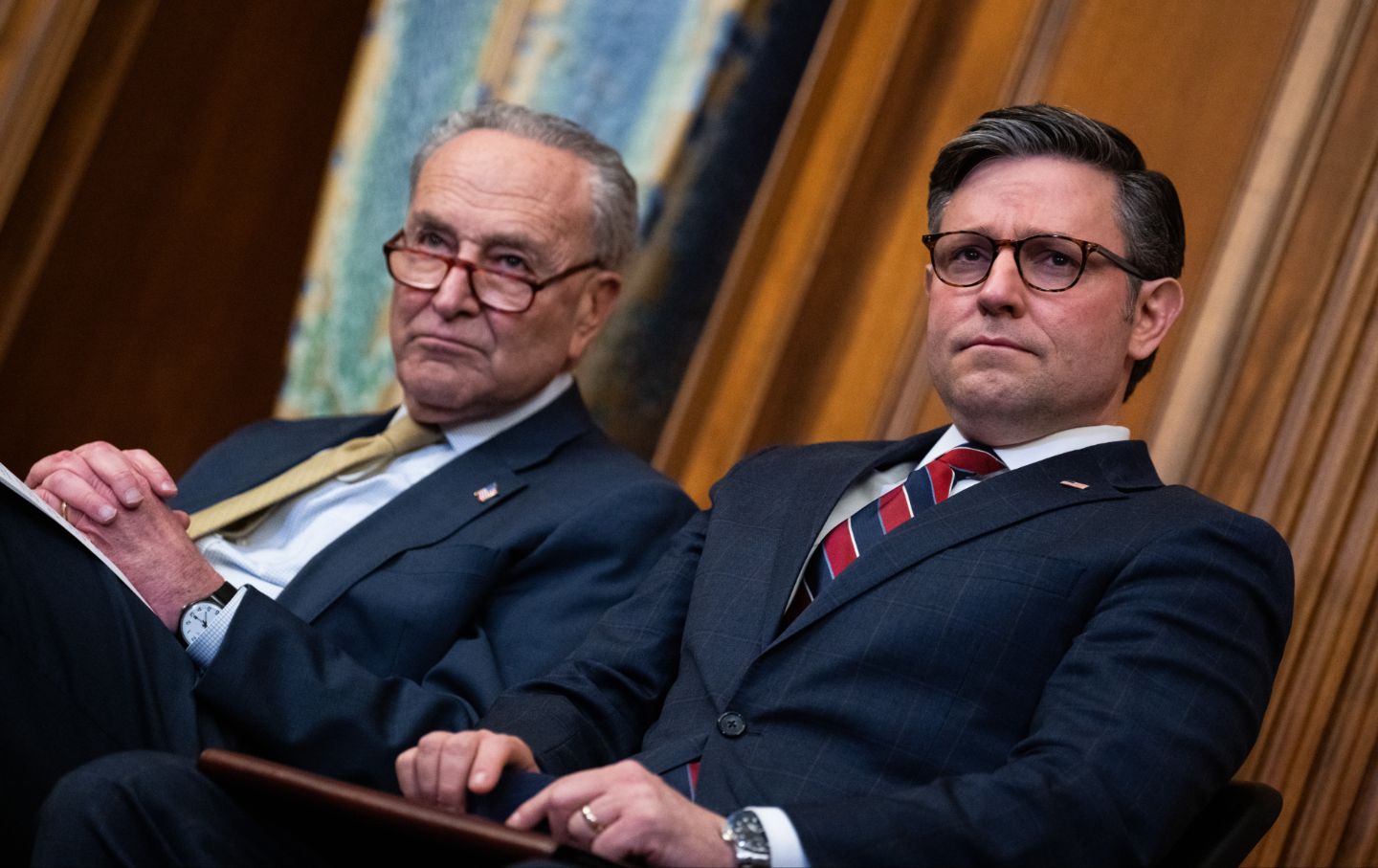
Democrats Must Do Everything They Can to Block the Dangerous Nonprofit Bill Democrats Must Do Everything They Can to Block the Dangerous Nonprofit Bill
The House passed a bill aimed at giving the government sweeping powers to crush nonprofits and attack supporters of Palestine. Democrats need to stand firmly in its way.
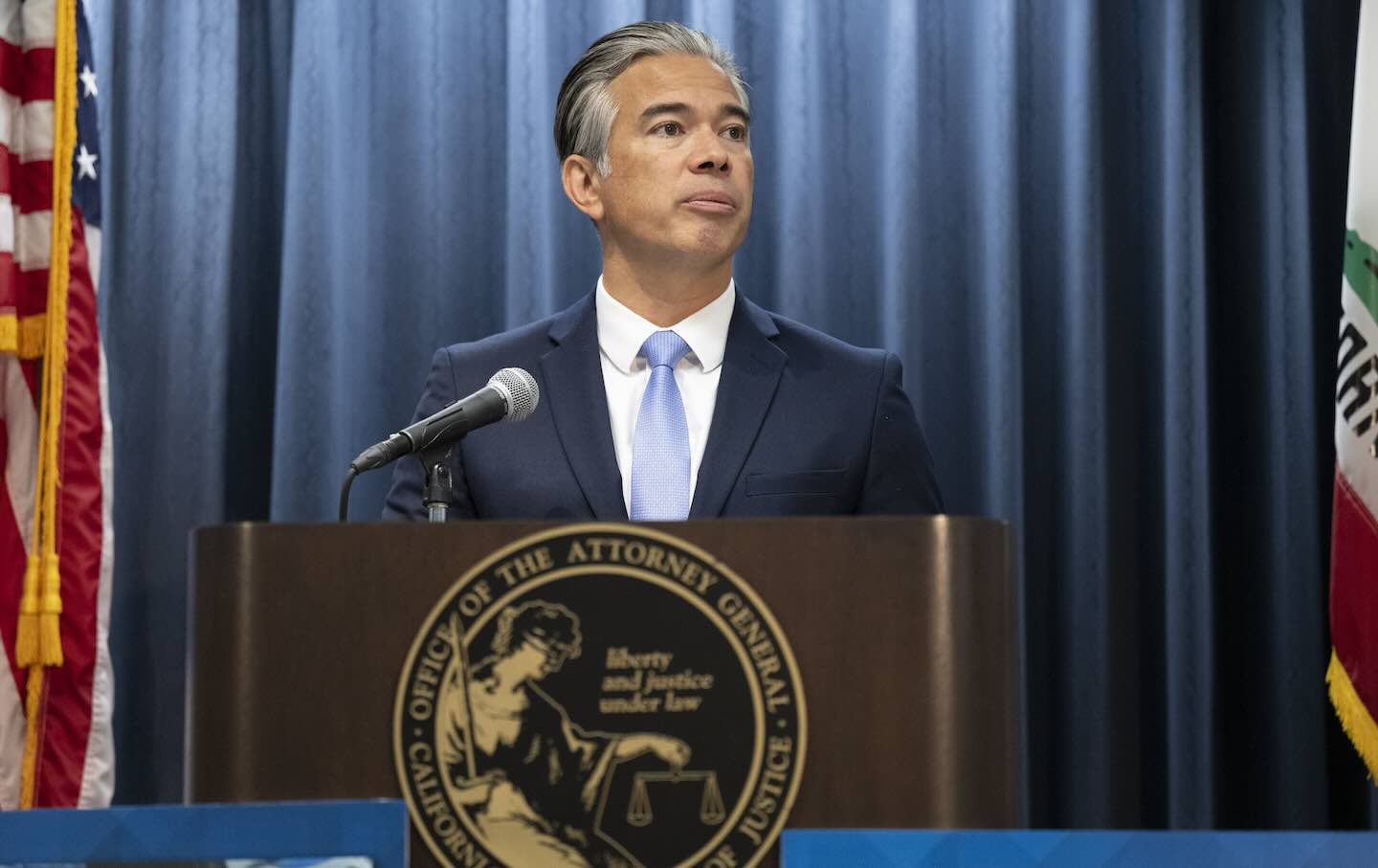
California Is Ready to Go Toe to Toe With Trump 2.0 California Is Ready to Go Toe to Toe With Trump 2.0
“We’ve thought about all the possibilities, and have prepared for every one of them,” said AG Rob Bonta, “and are ready to take action when there’s any unlawful activity.”
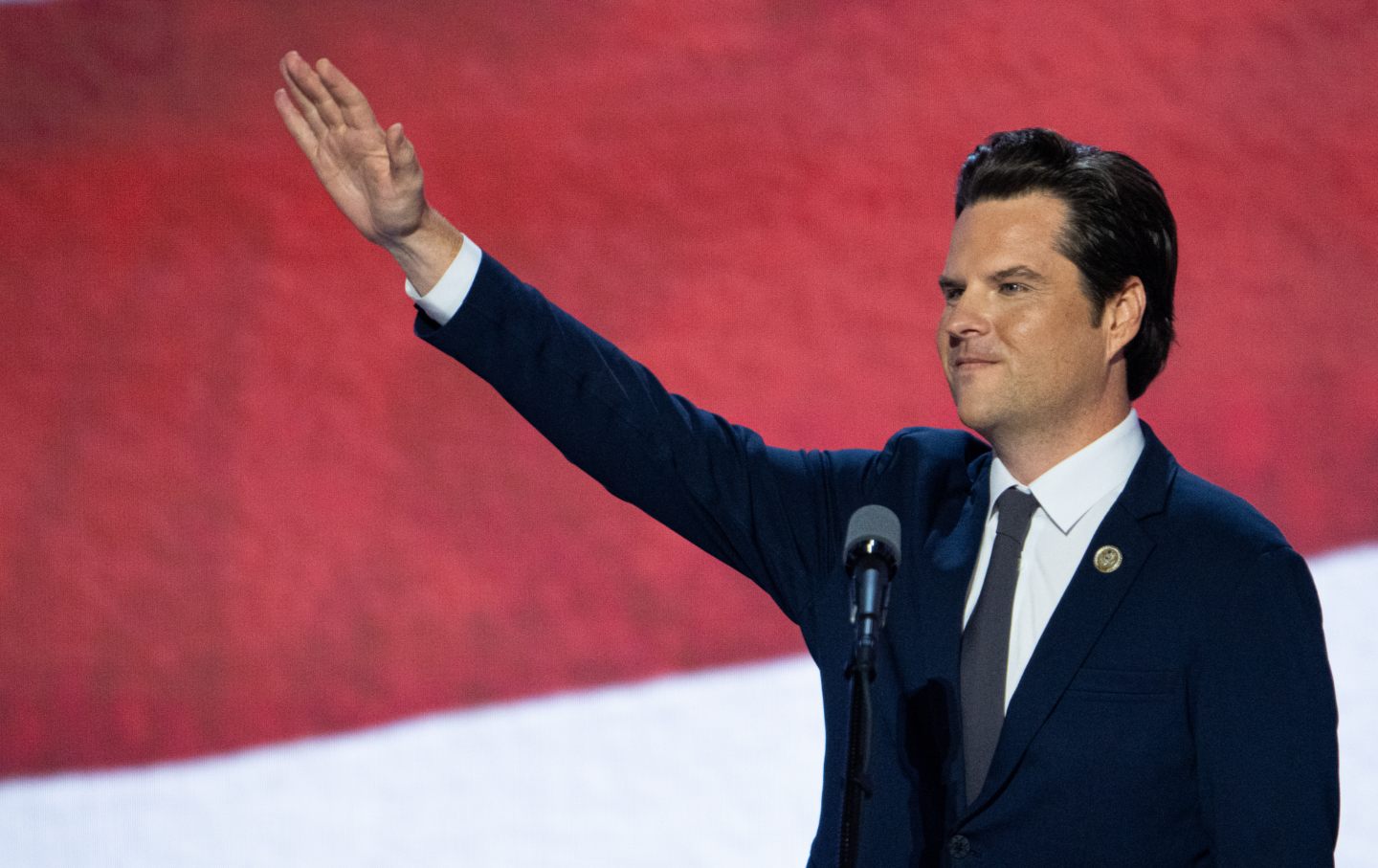
BREAKING: Matt Gaetz Quits, and Journalism Still Matters—a Lot BREAKING: Matt Gaetz Quits, and Journalism Still Matters—a Lot
Forty-five minutes after CNN contacted Trump’s attorney general nominee about additional allegations of sexual misconduct, he was done.

The Red Wave Didn’t Hit Statehouses in This Election The Red Wave Didn’t Hit Statehouses in This Election
State-level Democrats largely held their ground, even scoring key victories in battleground states—and under Trump, that’s going to matter.
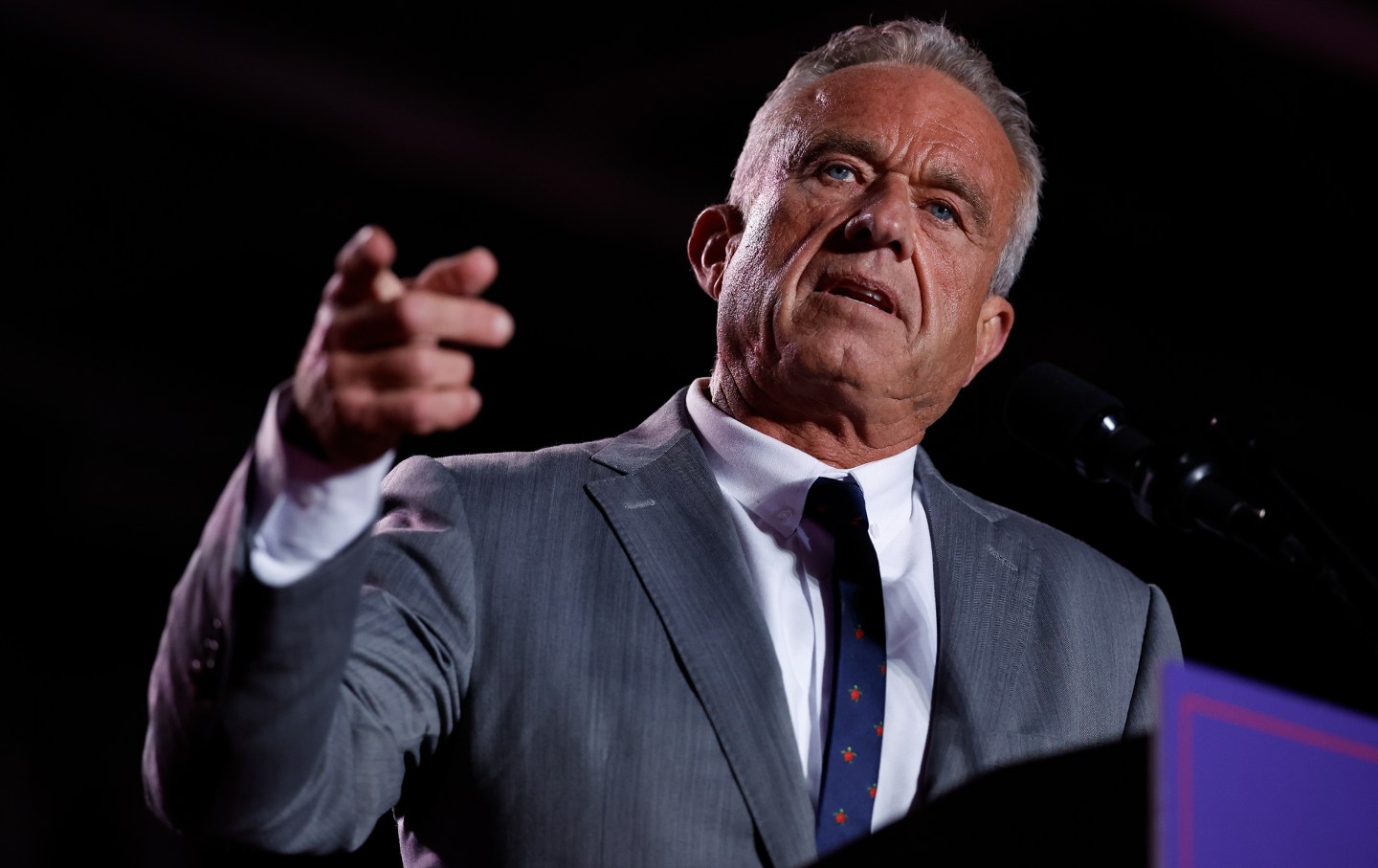
How Nominally Pro-Choice RFK Jr. Can Get Anti-Abortion Groups to Back His HHS Nomination How Nominally Pro-Choice RFK Jr. Can Get Anti-Abortion Groups to Back His HHS Nomination
He can pick a strident abortion opponent like Roger Severino, who wrote the Project 2025 chapter on HHS, as his number two.

